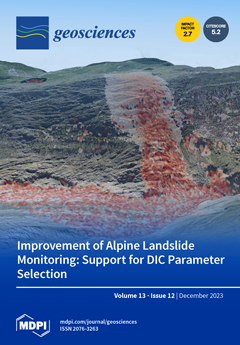Melted rocks (clinkers and paralavas) of the Mongolian combustion metamorphic (CM) complexes were formed during modern and ancient (since the Quaternary) wild-fires of brown coal layers in the sedimentary strata of the Early Cretaceous Dzunbain Formation. According to XRD, Raman spectroscopy, and SEM-EDS
[...] Read more.
Melted rocks (clinkers and paralavas) of the Mongolian combustion metamorphic (CM) complexes were formed during modern and ancient (since the Quaternary) wild-fires of brown coal layers in the sedimentary strata of the Early Cretaceous Dzunbain Formation. According to XRD, Raman spectroscopy, and SEM-EDS data, cordierite, sekaninaite, indialite, ferroindialite, silica polymorphs, mullite, Fe-mullite, anhydrous Al-Fe-Mg silicate spinel (presumably new mineral), and other phases were identified. It has been established that isomorphic impurity of potassium in the cordierite-group minerals does not correlate with their crystal structure (hexagonal or orthorhombic). Indialite and ferroindialite retained their hexagonal structure in some fragments of the CM rocks, possibly due to the very fast cooling of local zones of sedimentary strata and the quenching of high-temperature K-rich peraluminous melt. Clinkers, tridymite–sekaninaite, and cristobalite–fayalite ferroan paralavas were produced by partial melting of Fe-enriched pelitic rocks (mudstone, siltstone, and silty sandstone) in a wide temperature range. The formation of mullite, Fe-mullite, and Al-Fe-Mg silicate spinel in clinkers developed from dehydration–dehydroxylation and incongruent partial melting of Fe-enriched pelitic matter (Al-Mg-Fe-rich phyllosilicates, ‘meta-kaolinite’, and ‘meta-illite’). Large-scale crystallization of these minerals in the K-rich peraluminous melts occurred, presumably, in the range of
T > 850–900 °C. The subsurface combustion of coal layers heated the overburden pelitic rocks from sedimentary strata to
T > 1050 °C (judging by the formation of cordierite-group minerals) or locally till the melting point of detrital quartz grains at
T > 1300 °C and, possibly, till the stability field of stable β-cristobalite at
T > 1470 °C. Ferroan paralavas were formed during the rapid crystallization of Fe-rich silicate melts under various redox conditions. From the analysis of the liquidus surface in the Al
2O
3–FeO–Fe
2O
3–SiO
2 major-oxide system, it follows that the least high-temperature (<1250 °C) and the most oxidizing conditions occurred during the crystallization of mineral assemblages in the most-enriched iron silicate melts parental for cristobalite–fayalite paralava.
Full article





